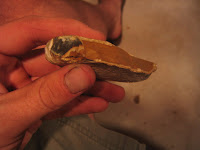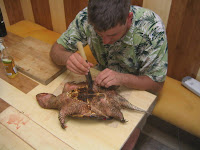
This first shot is an interesting mystery we have yet to solve. My friend Rod and I went out for an afternoon to do a little bow drill and exploring on the hills above the Piney Branch creek here in DC.
There were several trees in the area with these unidentified markings. As you can see from the photo there are squirrel tracks on the same branch for contrasts. They were on both horizontal and vertical branches, and are 1/8" to 1/4" deep, running 1/2 to 2/3 of the way around the branch. Any guesses?
 Besides being a beautiful and wild oasis in the heart of the city, this particular tributary of Rock Creek is a well known archaeological site. Here is a link to a good article.
Besides being a beautiful and wild oasis in the heart of the city, this particular tributary of Rock Creek is a well known archaeological site. Here is a link to a good article.Native Americans quarried stone here for thousands of years, everywhere you look there are piles of rock broken by ancient flintknappers, many showing patterned flaking.
Quartzite is available in cobbles throughout the Washington DC and Northern VA area, but Piney Branch holds a particularly fine-grained and flakeable variety, as well as a dazzling array
of colors- red, blue, purple, green, tan and clear, banded and sparkling.

My walks here are slow, as you can feel the ancients tool makers around you, sense them as you hold the same stones that they once held. Two years ago I wouldn't have even recognized these artifacts, since I had never knapped this kind of stone. But once you examine them closely, they start popping out everywhere, like a word you just learned. Then, when you realize the massive scale of this workshop, and the shear volume of artifacts surrounding you, it's nearly impossible not to be awestruck.



























